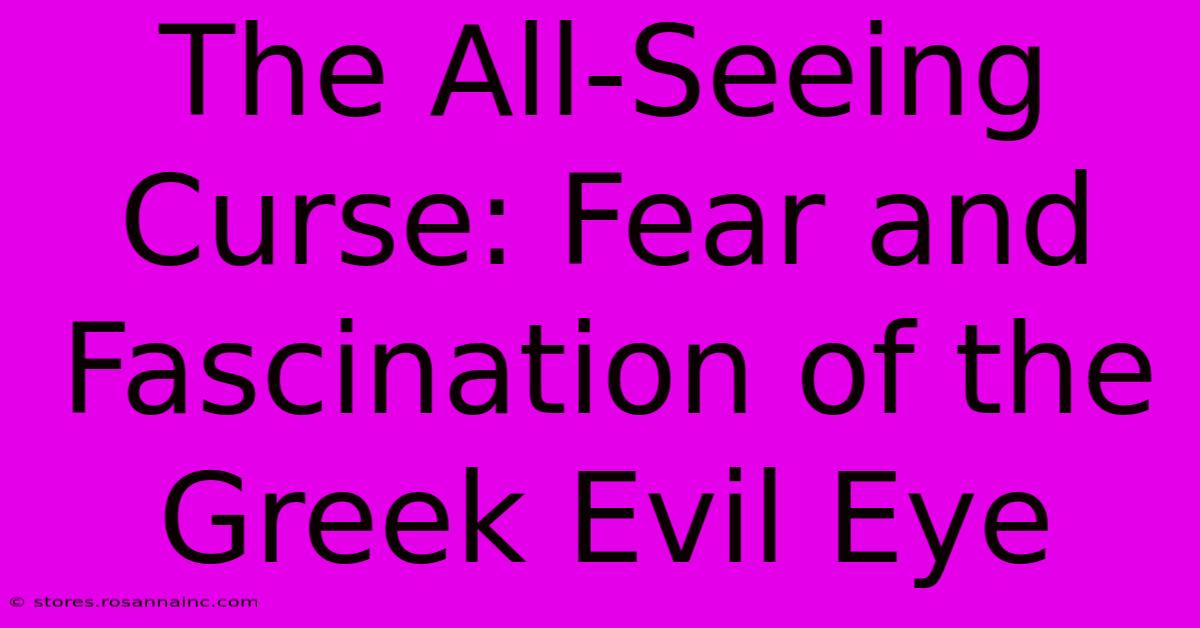The All-Seeing Curse: Fear And Fascination Of The Greek Evil Eye

Table of Contents
The All-Seeing Curse: Fear and Fascination of the Greek Evil Eye
The "mati," or evil eye, is more than just a superstition in Greece; it's a deeply ingrained cultural belief, weaving its way through daily life, art, and even modern anxieties. This potent symbol, representing the power of malevolent envy, has captivated and terrified generations, inspiring both fear and a fascinating, almost obsessive, need for protection. This article delves into the history, symbolism, and enduring legacy of the Greek evil eye.
A History Steeped in Legend
The concept of the evil eye, or matiasma, isn't uniquely Greek. Beliefs in the power of envious glances to inflict harm are found in numerous ancient cultures across the globe. However, the Greek manifestation is particularly potent and visually striking. Its roots can be traced back to ancient Greece, appearing in literature and mythology, showcasing a persistent fear of malevolent intent. The belief persisted through the Byzantine Empire and continues to thrive in modern Greece and among Greek diaspora communities worldwide. The power of the evil eye wasn't limited to petty jealousies; it was believed capable of causing illness, misfortune, even death.
The Symbolism of the Evil Eye
The evil eye's visual representation is almost universally recognized: a blue, often glass, amulet depicting a stylized eye. The bright blue color is believed to ward off the evil eye's gaze, while the eye itself serves as a powerful symbol of vigilance and protection. The very act of wearing an evil eye amulet is a powerful statement, a declaration of defiance against the unseen forces of envy and ill-will. Many believe that the amulet absorbs the negative energy directed at the wearer, preventing it from causing harm.
More Than Just a Charm: The Cultural Significance
The evil eye isn't just a trinket; it's woven into the fabric of Greek culture. You'll find it adorning everything from jewelry and keychains to houses and cars. Its presence is a constant reminder of the potential for unseen harm, but also a testament to the power of protective measures.
Practical Applications and Rituals
The use of the evil eye amulet is only one facet of the broader belief system. Many Greeks employ various rituals and practices to safeguard themselves and their loved ones. These can include:
- Spit three times: A common reaction to a compliment, designed to deflect any potential evil eye.
- Use of protective charms: These are not limited to the blue eye; other protective symbols and amulets exist within Greek tradition.
- Verbal incantations: Prayers and protective phrases are used to ward off malevolent spirits and envious gazes.
The Enduring Power of the Evil Eye
Despite advancements in science and medicine, the belief in the evil eye persists, particularly among older generations. This enduring power showcases its deep cultural roots and the enduring human fear of the unseen and the uncontrollable. It's a testament to the powerful role of cultural beliefs in shaping individual and collective anxieties.
Modern Interpretations and Psychology
While some view the evil eye as a superstition, others see it as a reflection of deeper psychological anxieties – the fear of envy, the vulnerability to the judgments of others, and the inherent uncertainty of life. In this sense, the evil eye serves as a potent symbol of these anxieties, offering a tangible way to address and mitigate them.
The Evil Eye Today: A Global Phenomenon
The Greek evil eye's influence extends far beyond Greece's borders. Its popularity as a fashion statement and protective amulet has spread globally, embraced by individuals who may not necessarily subscribe to the full traditional belief system. Its enduring appeal lies in its captivating symbolism, its powerful visual aesthetic, and the enduring human desire for protection against unseen forces.
In conclusion, the Greek evil eye is more than a mere superstition; it's a complex cultural phenomenon that reflects anxieties about envy, the unseen, and the precariousness of life. Its enduring presence in Greek culture and its growing popularity worldwide showcases its captivating power and the human need for protection against perceived threats, both seen and unseen.

Thank you for visiting our website wich cover about The All-Seeing Curse: Fear And Fascination Of The Greek Evil Eye. We hope the information provided has been useful to you. Feel free to contact us if you have any questions or need further assistance. See you next time and dont miss to bookmark.
Featured Posts
-
A Compass To Compassion Uncover The Guiding Star Of Compassion Internationals Address
Feb 06, 2025
-
Expand Your Horizons Harness The Power Of The Widest Camera Lens Ever
Feb 06, 2025
-
The Ultimate Guide To Conference Room Rentals Plan Your Event Like A Pro
Feb 06, 2025
-
A Beacon Of Gynecological Expertise Illuminating The Path To Optimal Womens Health
Feb 06, 2025
-
Get Ready To Bloom Daisy Dnd Gel Polish Set For Enchanting Nails
Feb 06, 2025
